
A tattoo is a form of body modification made by inserting tattoo ink, dyes, and/or pigments, either indelible or temporary, into the dermis layer of the skin to form a design. Tattoo artists create these designs using several tattooing processes and techniques, including hand-tapped traditional tattoos and modern tattoo machines. The history of tattooing goes back to Neolithic times, practiced across the globe by many cultures, and the symbolism and impact of tattoos varies in different places and cultures.

Scarification involves scratching, etching, burning/branding, or superficially cutting designs, pictures, or words into the skin as a permanent body modification or body art. The body modification can take roughly 6–12 months to heal. In the process of body scarification, scars are purposely formed by cutting or branding the skin by various methods. Scarification is sometimes called cicatrization.
Irezumi is the Japanese word for tattoo, and is used in English to refer to a distinctive style of Japanese tattooing, though it is also used as a blanket term to describe a number of tattoo styles originating in Japan, including tattooing traditions from both the Ainu people and the Ryukyuan Kingdom.

Genital tattooing is the practice of placing permanent marks under the skin of the genitals in the form of tattoos.

Body painting is a form of body art where artwork is painted directly onto the human skin. Unlike tattoos and other forms of body art, body painting is temporary, lasting several hours or sometimes up to a few weeks. Body painting that is limited to the face is known as "face painting". Body painting is also referred to as "temporary tattoo". Large scale or full-body painting is more commonly referred to as body painting, while smaller or more detailed work can sometimes be referred to as temporary tattoos.

Permanent makeup, also known as permanent cosmetics, derma-pigmentation, micro-pigmentation, and cosmetic tattooing, is a cosmetic technique which employs tattoos as a means of producing designs that resemble makeup, such as eye-lining and other permanent enhancing colors to the skin of the face, lips, and eyelids. It is also used to produce artificial eyebrows, particularly in people who have lost them as a consequence of old age, disease, such as alopecia totalis, chemotherapy, or a genetic disturbance, and to disguise scars and hypopigmentation in the skin such as in vitiligo. It is also used to restore or enhance the breast's areola, such as after breast surgery.
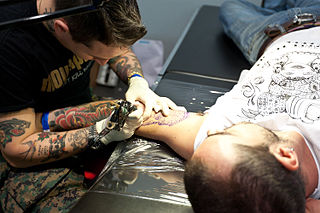
A tattoo artist is an individual who applies permanent decorative tattoos, often in an established business called a "tattoo shop", "tattoo studio" or "tattoo parlour". Tattoo artists usually learn their craft via an apprenticeship under a trained and experienced mentor.
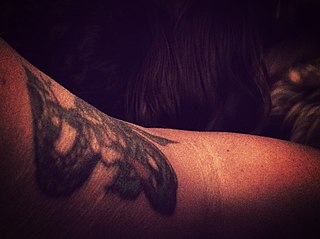
Tattoo removal is the process of removing an unwanted tattoo. The process of tattooing generally creates permanent markings in the skin, but people have attempted many methods to try to hide or destroy tattoos.
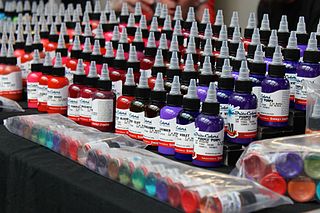
Tattoo inks consist of pigments combined with a carrier, used in the process of tattooing to create a tattoo in the skin. These inks are also used for permanent makeup, a form of tattoo.
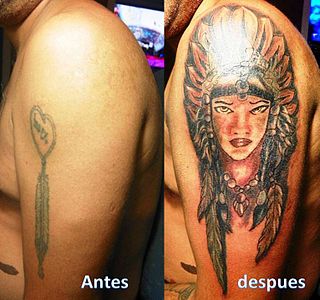
A cover-up is a tattoo done over an unwanted past tattoo, scars, or symptoms of a skin condition. It is one of the two main options of removing an unwanted tattoo; the other option being laser removal. Covering up an unwanted tattoo is generally cheaper, less painful and an overall easier solution than tattoo removal. A person may choose to get a cover-up over an older tattoo for aesthetic reasons, such as to enhance or replace a faded tattoo, or to erase an unwanted reminder. Numerous celebrities have employed tattoo artists to cover up existing tattoos, often after the breakup of a relationship. Some tattoo artists volunteer to cover hateful and gang-related tattoos with new designs for free.
Nicholas Humberto Hurtado, known as Nikko Hurtado, is an American tattoo artist who specializes in colored portraiture. His signature hyper-realistic color portraits have made him a renowned figure in the tattoo industry with a massive celebrity client list. He has numerous television appearances on shows such as LA Ink, Tattoo Wars, and Ink Master, becoming a judge on Ink Master in 2022. Hurtado is the founder of Black Anchor Collective in Hesperia, California, and Black Anchor Los Angeles in Hollywood, California, both within Black Anchor Worldwide.

The Peʻa is the popular name of the traditional male tatau (tattoo) of Samoa, also known as the malofie. It is a common mistake for people to refer to the pe'a as sogaimiti, because sogaimiti refers to the man with the pe'a and not the pe'a itself. It covers the body from the middle of the back to the knees, and consists of heavy black lines, arrows, and dots.
A variety of health effects can result from tattooing. Because it requires breaking the skin barrier, tattooing carries inherent health risks, including infection and allergic reactions. Modern tattooists reduce such risks by following universal precautions, working with single-use disposable needles, and sterilising equipment after each use. Many jurisdictions require tattooists to undergo periodic bloodborne pathogen training, such as is provided through the Red Cross and the U.S. Occupational Safety and Health Administration.

Sailor tattoos are traditions of tattooing among sailors, including images with symbolic meanings. These practices date back to at least the 16th century among European sailors, and since colonial times among American sailors. People participating in these traditions have included military service members in national navies, seafarers in whaling and fishing fleets, and civilian mariners on merchant ships and research vessels. Sailor tattoos have served as protective talismans in sailors' superstitions, records of important experiences, markers of identity, and means of self-expression.

The process or technique of tattooing, creating a tattoo, involves the insertion of pigment into the skin's dermis. Traditionally, tattooing often involved rubbing pigment into cuts. Modern tattooing almost always requires the use of a tattoo machine and often procedures and accessories to reduce the risk to human health.
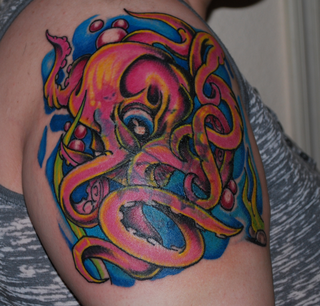
New school is a tattooing style originating as early as the 1970s and influenced by some features of old school tattooing in the United States. The style is often characterized by the use of heavy outlines, vivid colors, and exaggerated depictions of the subject. New school also represents a transition towards openness in the sharing of techniques in tattooing.
Microblading is a tattooing technique in which a small handheld tool, made of several tiny needles, is used to add semi-permanent pigment to the skin. Microblading differs from standard eyebrow tattooing, a form of permanent makeup, as each hair stroke is created by hand with a blade that creates fine slices in the skin, whereas eyebrow tattoos are done with a tattoo machine. Microblading is used on eyebrows to create, enhance, or reshape their appearance in shape and color. It deposits pigment into the upper region of the dermis, so it fades more rapidly than traditional tattooing techniques. Microblading is also sometimes called eyebrow embroidery, eyebrow feathering, microstroking, 3D eyebrows, nanoblading or hair-like strokes.

Batok, batek, patik, or batik, among other names, are general terms for indigenous tattoos of the Philippines. Tattooing on both sexes was practiced by almost all ethnic groups of the Philippine Islands during the pre-colonial era. Like other Austronesian groups, these tattoos were made traditionally with hafted tools tapped with a length of wood. Each ethnic group had specific terms and designs for tattoos, which are also often the same designs used in other art forms and decorations such as pottery and weaving. Tattoos range from being restricted only to certain parts of the body to covering the entire body. Tattoos were symbols of tribal identity and kinship, as well as bravery, beauty, and social or wealth status.

The armadillo shoe is a high fashion platform shoe created by British fashion designer Alexander McQueen for his final collection, Plato's Atlantis. Only 24 pairs exist: 21 were made during the initial production in 2009, and three were made in 2015 for a charity auction. The shoes are named for their unusual convex curved shape, said to resemble an armadillo. Each pair is approximately 12 inches (30 cm) from top to sole, with a 9-inch (23 cm) stiletto heel; this extreme height caused some models to refuse to walk in the Plato's Atlantis show. American singer Lady Gaga famously wore the shoes in several public appearances, including the music video for her 2009 single "Bad Romance".















